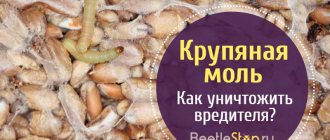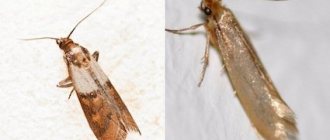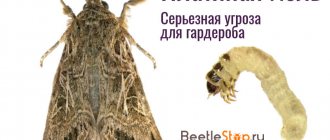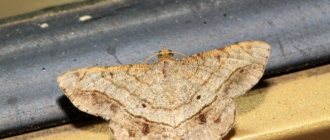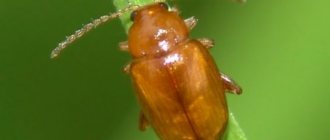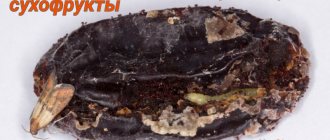When food moths appear in their home, many housewives begin to panic and look for sources of the appearance of flying moths. Some housewives, on the contrary, do not show any concern, believing that this pest is not dangerous. The insect is quite unpleasant, so everyone is trying to get rid of it. The task will be simplified if a breeding site is found.
This is a rather unpleasant process, takes a lot of time and costs a lot. To prevent various insects from appearing in your home, you need to know preventive measures. Knowing how to prevent the appearance of unpleasant insects, bugs or worms, you can hope that you will not have to subsequently fight with larvae, and then with adult food moths.
Food moth: what is it?
The food or grain moth is a pest that is characterized by a short reproduction cycle, presenting an adult in the form of a butterfly. Adults are distinguished by a beige tint, and sometimes light brown. The larvae can reach a length of about 2 cm, depending on the species. This particular type of moth is the most harmful to humans. She is quite voracious and eats everything that is edible: cereals, nuts, fruits, etc. If it is not detected in time, it can devour all food supplies.
An adult can live only a few days, after which it lays eggs and dies. It is during the breeding season, when the individual is no longer able to fly, that it begins to devour any food. The breeding period can last up to six days. One can only imagine how many products moths can spoil during this period.
This process can speed up significantly if the room is warm and humid. Therefore, if you don’t see flying butterflies, this does not mean at all that there are no moths. It’s just that during this period she can easily devour food.
Important! It is necessary not only to carry out the fight against moths once. It is necessary to regularly check containers with dry products for the presence of food moth larvae.
Stages of development
The lifespan of an insect ranges from several days to 2 - 3 weeks. But during this time, female grain moths manage to lay up to 150 eggs. They develop from 4 days to a month. Eggs are laid directly on the grains.
The larvae go through a stage of development from a caterpillar to a butterfly in grains. In corn there can be 2-3 individuals at the same time, in smaller grains there can be one. The lifespan of the caterpillar is up to 3 weeks, after which it gnaws a hole in the shell of the grain for the butterfly to exit and pupates.
In summer, the development of the pupa lasts about a week; in the cold season, the process is delayed. The optimal temperature for passing through development stages is a temperature of 13 degrees. In nature, up to two generations mature per season, in storage - up to 8.
How does this parasite appear?
This issue seriously worries many housewives, and they believe that they themselves are to blame for the appearance of these pests in the kitchen. In reality, everything looks completely different. After all, most products, if not all, are bought in a store, where they are purged and can become infected with food moths. This is due to the fact that at all bases products are not stored as prescribed by the rules. In addition, moths can enter the room through windows or ventilation.
Food moths choose special places for their life activities. For example:
- Among the cereals It can feel great in places where rice, rolled oats, oatmeal, and pasta are stored. Even in bags of cereals, food moths can be found there.
- Among the nuts. Moths can be found in shelled peanuts, under the shells of walnuts, etc.
- Among dried fruits. Where dried apricots, prunes and raisins are stored, you can notice how they become covered with some kind of film over time. It can be assumed that they are infested with moths.
- Among the cardboard boxes. Moth larvae are found even in unopened packets of tea, oatmeal or corn flakes.
- If it is not possible to get rid of the moth for many years, then we can assume that it lives in this room, hiding in various crevices and other secluded places. Sometimes it is found in household appliances that are not used.
- Some experts claim that moths are afraid of garlic, but this is not at all true, since they were found even among garlic.
- She can even live in foods that she does not eat. This can be salt, soda and other bulk products. Therefore, when inspecting, you need to pay attention to all products.
The only place where you won't find moths is where liquid products are stored.
If this pest is detected, then do not panic. On the contrary, we need to get together and begin to destroy this pest.
Chemical methods of destruction
Methods include several options:
- Gas disinfestation using hydrogen phosphorous;
- Wet processing using concentrated solutions;
- Aerosol disinfection;
- A combination of all methods.
- Phosphorous hydrogen
Fumigation is carried out using this substance. The pest is destroyed in several ways. However, they all require special equipment. The first option is that the grain is moved, and in the process, tablets with insecticides are laid out. The second is that the backfill layer is processed and covered with plastic film or other material that does not allow air to pass through. The third option is that the grain is placed in a special chamber where it is processed.
How harmful and dangerous are moths?
Many ignorant people believe that food moths are absolutely harmless to humans. In fact, everything is much more serious. The fact is that an adult can lay up to 500 eggs. By the time the larva becomes an adult, it will have time to change its skin several times, and through its vital activity it contaminates food. As a result, cereals, nuts and other foods contain a lot of feces and old insect skin. If you regularly eat contaminated foods, you can provide yourself with:
- Food poisoning, which will lead to serious intoxication of the body.
- An allergic reaction, including angioedema, which can be fatal.
- Decreased immunity.
Most experts say that if this pest is discovered, it should be gotten rid of as quickly as possible. Moths are especially dangerous for children. Their bodies are not yet strong enough, so eating contaminated foods can lead to serious consequences.
Appearance of an insect
The grain moth is quite easy to recognize, as it has its own distinctive characteristics.
- The wings are yellow-brown. The hind wings of the grain moth are different - they are silver-gray.
- The insect has a nondescript head color, white with a silver tint.
- The wings of the grain moth are decorated with a special brown ornament. Their span is up to 15 millimeters.
- The body length is from 6 to 6.5 millimeters.
If you look at the photo, you can see that in its appearance the grain moth resembles a house moth, which damages natural fabrics in wardrobes. The moth has several names - in addition to grain, it can be called bread, barley or granary. Its name depends on the place where the butterfly lives. They can live on grain and flour.
The pest can be brought into the home from food warehouses and storage facilities, where the insect lives on grain, from where it gets to food stores and then to the direct consumer.
The grain moth can be seen not only in Russia and other parts of Europe. It is found in countries such as Brazil and Australia.
Methods for controlling food moths
The fight against food moths should begin with an inspection of all products in the kitchen. At the slightest suspicion of the presence of these pests, it is better to throw away food. You should be guided by the principles: health is more valuable. If a pest is detected, it is better to pack it tightly, for example, in a bag and tie it up. It should be remembered that the moth loves to travel and if it is not closed, it may return. There are a number of recommendations that will help get rid of this pest. For example:
- You should not hide food in the refrigerator, since under the influence of low temperatures the larvae simply fall asleep. If you return them to their familiar environment, they will easily come to life and begin their activities.
- Eggs and larvae die only at high temperatures, so it is better to steam the cereals in the oven for half an hour. Even in such conditions, some larvae can survive. Therefore, it is better to do this a couple of times.
- If cereals and herbs are stored in tin cans, as our grandmothers did, then moths are unlikely to get inside. The same can be said about glass containers, wooden containers and foil. But it can easily chew through fabric, paper and even plastic lids. It is better to store food in glass containers with tight-fitting lids. In any case, this parasite can be detected through the glass and then the moth will not be able to move to other products.
- All containers where moths were found should be washed in a vinegar solution. Neither ordinary soap nor washing powder are dangerous for moths: moths can even live in washing powder packets. You can additionally rinse the containers with a soap solution to get rid of the specific odor.
Interesting! It is unlikely that you will be able to get rid of moths unless you throw away contaminated food. Activities such as general cleaning in the kitchen, washing all the furniture and the entire room using a vinegar solution, will also not hurt. This is the only way to get rid of this dangerous pest for humans.
Means for combating food moths are divided into two categories:
- Elimination insecticides. Chemicals are aimed at destroying eggs, larvae and adults.
- Repellents. These are substances of natural origin that are aimed at repelling insects. The preparations do not destroy insects, but facilitate their migration to other areas.
Aerosols
Aerosols are considered the most effective means of combating moths in an apartment. The market for such products offers a wide range of products that can cope with the invasion of these parasites in a short period of time.
Popular products include:
- Antimol. This product can be used on kitchen furniture and fabrics. This remedy can be effective for one year.
- Armol. This remedy quickly destroys moths, acting on both adult individuals and their larvae.
- Battalion commander A universal remedy that acts on all types of moths. The advantage of the drug is that it is harmless to pets. Therefore, it can be used on any surface.
In any case, you can contact sellers who have the necessary information for advice. At the same time, it is necessary to take into account the presence of children in the house. Before disinfection begins, you will have to temporarily remove children, animals, and even indoor plants from the premises. After a certain amount of time, the room must be well ventilated, since insects do not tolerate fresh air well.
Using traps
If a flying moth is spotted, it must be destroyed immediately. To do this, you can arm yourself with a regular newspaper. The moth does not fly fast, so it is not difficult to catch it. As a last resort, you can use commercial traps, like flytraps. The traps are lubricated with a special substance that attracts insects with its smell. The moth lands and sticks to the surface, after which it dies.
The Aeroxon moth trap has good data. The surface is covered with a special adhesive that does not lose its properties for a long time. It is not a problem to purchase such a trap at any hardware store, and its cost does not exceed 200 rubles. It is enough to purchase one trap and you can get rid of all the adults. In extreme cases, you will need another one.
How to fight food moths with home remedies
Traditional methods of fighting moths
The following products, proven over the years, are suitable for fighting moths:
- Bay leaf. It has an aroma that moths do not like. To combat moths, it is enough to spread leaves in all places where moths may appear.
- The smell of cloves and geranium also repels moths. To combat this pest, you need to soak cotton pads in the oils of these plants and place them in the kitchen.
- Natural camphor repels moths no less effectively.
Signs of infection
Size of food moths and larvae.
It is not difficult to find out that there are moths in the house: fluttering grayish butterflies appear in the kitchen or in food pantries. Most often they can be seen in the evening: insects fly out to bask in the warm radiation of switched on electrical appliances. White caterpillars can be seen on cabinet doors, walls and even ceilings.
Pests lay eggs directly in food products. They do this on purpose: the hatched moth larvae need food. Cobwebs in semolina or flour are also a sign of infection: the adult caterpillar is spinning threads for a cocoon in which it will turn into an adult.
Preventive actions
It is better to carry out preventive measures than to later fight with larvae and adults of food moths. A number of recommendations can serve as such measures to help minimize the likelihood of moths occurring in a residential area. For example:
- Before buying a product in a store, it must be carefully inspected. This is especially true for promotional products, which, as a rule, have exceeded their shelf life. It can be assumed that they are infested with these insects.
- After soaking cotton pads in lavender oil, they are laid out on kitchen cabinets. Bags of lavender, after drying, are an excellent place for moths to live.
- It is advisable to store products in glass containers, closed with the same lids. At the same time, it is better to monitor the temperature, since moths do not like dry and cool places.
- You should audit your household food supplies as often as possible. At the first hint of the appearance of these pests, it is better to throw away spoiled products, and it is better to treat their storage areas with a solution of water and vinegar.
- You should not stock up on large quantities of dried mushrooms, berries and fruits, as well as cereals. Enough to stock up for a couple of weeks. Usually food moths start in excess food.
In conclusion, it should be said that moths are not as harmless as some housewives imagine. Besides the fact that she is quite harmful, her presence is quite unpleasant. Food moth is a serious pest and, if not controlled, it can spoil a lot of food. This is especially true for large stocks that are designed for long-term storage. Therefore, it is better not to make massive reserves, but limit yourself to supplies for about two weeks.
In this regard, when either larvae or flying moths appear, it is necessary to urgently take measures to eliminate them. As for the method, any described above will do. The most important thing is to take measures when they appear, so as not to put a lot of effort into destroying them.
How to get rid of food moths in the kitchen. Methods of fighting moths.
Repellents
The products included in this group are recognized as absolutely safe for humans. The disadvantage of these products is that they destroy or repel only butterflies and have no effect on worms.
They are produced in the form:
- sticky trap tape that attracts butterflies;
- plates that repel pests from products.
For this reason, a food moth trap, like a plate, serves more as a means of prevention than active pest control.
Natural remedies
Essential oils - fir, lavender - will help get rid of parasites. You can use bouquets of dried lavender. Moths cannot tolerate the smell of strawberry soap, tobacco, dry orange peels, and pepper. You can use fresh geranium leaves.
Of all the folk remedies against moths, lavender is perhaps the most famous.
It is important to know that the products presented are repellents . They will only repel insects for a while. If moths have already infested the closet, you will have to use chemicals.
